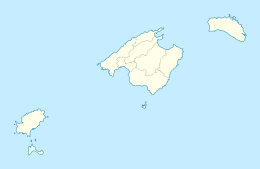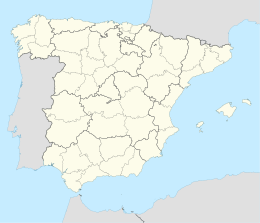This article needs additional citations for verification. (January 2021) |
Native name: Eivissa | |
|---|---|
 Flag of Ibiza | |
 Satellite view (2013) | |
| Geography | |
| Location | Balearic Sea |
| Coordinates | 38°59′N 1°26′E / 38.98°N 1.43°E |
| Archipelago | Balearic Islands, Pityusic Islands |
| Area | 571.6 km2 (220.7 sq mi) |
| Highest elevation | 475 m (1558 ft) |
| Highest point | Sa Talaiassa |
| Administration | |
Spain | |
| Autonomous Community | Balearic Islands |
| Province | Balearic Islands |
| Capital city | Ibiza Town |
| Largest settlement | Ibiza Town (pop. 51,872) |
| Government | Island Council of Ibiza |
| President | Vicente Marí (PP) |
| Demographics | |
| Population | 159,180 (1 January 2023) |
| Pop. density | 278.0/km2 (720/sq mi) |
| Languages | Catalan, Spanish |
 | |
| Official name | Ibiza, Biodiversity and Culture |
| Type | Mixed |
| Criteria | ii, iii, iv, ix, x |
| Designated | 1999 (23rd session) |
| Reference no. | 417 |
| Region | Southern Europe |

Ibiza (Spanish: [iˈβiθa]; Catalan: Eivissa [əjˈvisə]; see below) is a Spanish island in the Mediterranean Sea off the eastern coast of the Iberian Peninsula. It is 150 kilometres (93 miles) from the city of Valencia. It is the third largest of the Balearic Islands in area, but the second-largest by population. Its largest settlements are Ibiza Town (Catalan: Vila d'Eivissa, or simply Vila), Santa Eulària des Riu, and Sant Antoni de Portmany. Its highest point, called Sa Talaiassa (or Sa Talaia), is 475 metres (1,558 feet) above sea level.
Ibiza is well known for its nightlife and electronic dance music club scene in the summer, which attract large numbers of tourists. The island's government and the Spanish Tourist Office have worked toward promoting more family-oriented tourism.[1][2]
Ibiza is a UNESCO World Heritage Site.[3] Ibiza and the nearby island of Formentera to its south are called the Pine Islands, or "Pityuses".
- ^ Ibiza renews its party spirit Archived 3 June 2023 at the Wayback Machine, Luke Bainbridge, 27 June 2010 (The Guardian)
- ^ Inside the police crackdown on Ibizas endless party culture Archived 16 September 2020 at the Wayback Machine Michelle Lhooqe, 13 November 2015 (Vice TV website)
- ^ "Ibiza, Biodiversity and Culture". UNESCO. United Nations. Archived from the original on 25 October 2023. Retrieved 14 February 2018.

